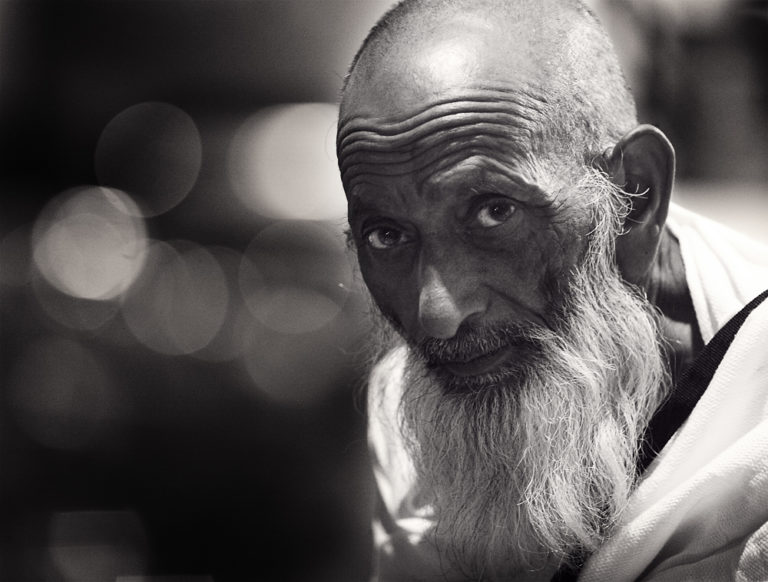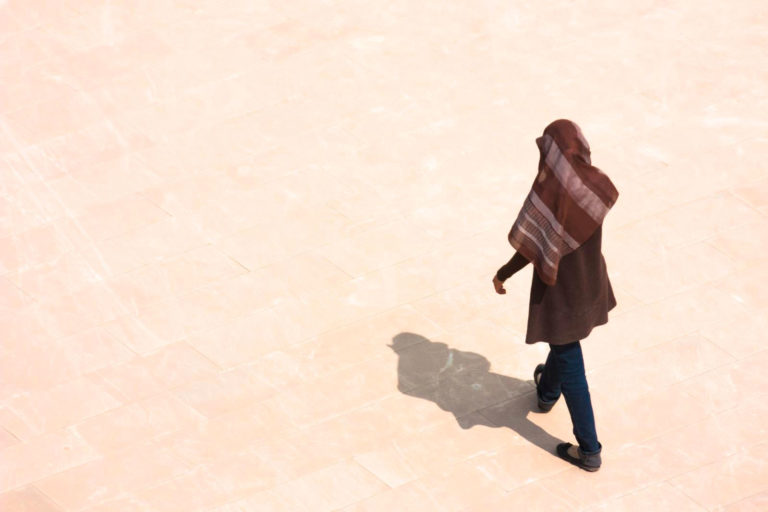
Image by Maitham Rushaidan/Flickr, Some Rights Reserved.
The Holiness of Being Found
It is time to go home.
In a few short days, it will be the season for Hajj. The Hajj, the annual Muslim pilgrimage, is the most recognizably Islamic of rituals — when pilgrims, clad in white, from all over the world arrive in Mecca.
It is also the most Abrahamic of rituals, connecting contemporary Muslims with the spiritual legacy of Abraham and Hagar. Today, it is also a contested ritual, as it forces Muslims to confront the ugliest aspects of rampant and uncontrolled capitalism and modernism in their holiest site.
In many ways, Hajj is a return, a re-union. It is an invitation to return to the center of our existence, where The One reigns supreme. The journey from the periphery of existence to the center of our being is recapitulated in the journey from far countries to Mecca.
We live in a state of constant scatteredness. We are everywhere, but here. The Hajj is re-centering, a remembering of who we are, and in whose image we are made.
In each of these countries, we face Mecca during our daily and nightly prayers. In the presence of the Ka’ba, we see that all who have been facing east, west, north, and south have been facing The One. It’s a powerful reminder of the plurality of paths and the unity of the destination.
How lovely would it be if we loved the path less, and the destination more. How lovely if we could love the cup less, and the water of life more. How lovely if we would learn to pray inside the Ka’ba of each other’s hearts.

The Hajj has had a powerful symbolism for Muslims, a powerfully egalitarian symbol of setting aside distinctions of class (though the 7,000 hotel suites serve as a bitter reminder of the persistence of class.) A reading of Malcolm X’s autobiography serves to remind one of the powerful impression Mecca leaves on its visitors:
“Never have I witnessed such sincere hospitality and overwhelming spirit of true brotherhood as is practiced by people of all colors and races here in this ancient Holy Land, the home of Abraham, Muhammad and all the other Prophets of the Holy Scriptures.
For the past week, I have been utterly speechless and spellbound by the graciousness I see displayed all around me by people of all colors.”
The Hajj is profoundly Abrahamic. The Hajj picks up the story of Abraham building the first temple for the One God in the desert, in Mecca. It takes us back to the origin of the same tradition that unites Judaism, Christianity, and Islam. It serves as a reminder that the true temple of God is the heart, which has to be perpetually cleansed of distractions “other” than God.
And the Hajj also connects us to the legacy of Hajar (Hagar), with her baby Ishmael (Ismail), left in the desert far from her family and support. During Hajj, Muslims run back and forth between hills as Hajar did, looking for water for her son.
I wonder how often we remember that some of the main rituals of the pilgrimage have us walking in the footsteps of a woman — abandoned, alone, frightened — and a single mother with no support. What would it be like for us to ponder that, in taking on our universal ritual, we do so by identifying with the experience of the most marginalized, the most impoverished, as Muslim feminists have reminded us.
I have written previously about the utter modernization of Mecca, which has largely meant a destruction of its historical heritage, sites of profound religious significance to many Muslims. In their place, we have seen an almost unrecognizable growth of luxury hotels, restaurants, and even shopping malls in Mecca. According to some estimates, some 90 percent of the historical sites in Mecca have been bulldozed in the last few decades under Saudi patronage.
The most monstrous of these architectural sites is the Abraj al-Bait, which looms large over the Ka’ba. The Guardian referred to it as “Big Ben on steroids.” The Independent chose another metaphor: Mecca was turning into Las Vegas. Gone is the symbolism of ancient Islamic architecture, which states that it would be the house of God that would rise above mundane architecture. Now it is the monstrous tower with its seven-star suites that serves as a mockery of the radical egalitarianism at the heart of the Hajj rituals.
A tragic combination of bad weather and (possibly) shoddy construction led to disastrous results right before the start of the Hajj season. The collapse of a giant crane on top of pilgrims in Mecca resulted in the death of 107 people.
As hard as it is for some to grasp it, when the news of the Hajj disaster broke, the response of the global Muslim community was not primarily anger or law suits. The almost global and universal response was to wish that the soul of the pilgrims be accepted by God, having died in such a holy place.
There is a grace in Mecca… Still.
After, below, and beyond the crass commercialization,
Far loftier than the endless shopping malls, there remains the sanctity.The sanctity comes not merely from “above.”
We bring the holiness.
We bring the sanctity.
For thousands of years the pilgrims have brought their faith and hope and tears, searching for the One God who’s with us all along.We seek, and He finds.
That seeking, that finding, that being found… that is holy.



Share your reflection